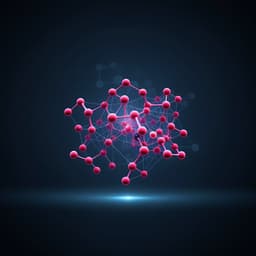
Chemistry
Electronic structure with direct diagonalization on a D-wave quantum annealer
A. Teplukhin, B. K. Kendrick, et al.
Discover the groundbreaking work of Alexander Teplukhin, Brian K. Kendrick, Sergei Tretiak, and Pavel A. Dub as they harness the power of the Quantum Annealer Eigensolver algorithm to tackle complex molecular electronic Hamiltonian problems using a D-Wave 2000Q quantum annealer. Their innovative approach not only reveals ground and excited electronic states in small molecular systems but also sets the stage for advancements in electronic structure methods. Explore their promising results that pave the way for further optimization solutions!
~3 min • Beginner • English
Introduction
The paper addresses the challenge of solving the electronic structure problem—specifically, eigenvalues and eigenvectors of the electronic Hamiltonian—which classically scales factorially with electron number and becomes infeasible beyond roughly 20 electrons. Quantum computation (gate-based and adiabatic/annealing) promises polynomial scaling, but current hardware is limited: gate-based devices have ~50–70 noisy qubits and present-day annealers do not implement non-stoquastic Hamiltonians. Prior near-term efforts largely target gate-based methods such as VQE and FQE for small molecules. Using quantum annealers for electronic structure remains limited, with only two prior approaches that map second-quantized Hamiltonians (via Jordan–Wigner or Bravyi–Kitaev) to QUBO/Ising forms but require qubit copying or many classically optimized variables and added constraints to reduce higher-order terms. The research question is whether a general, hardware-dominant Quantum Annealer Eigensolver can directly diagonalize electronic Hamiltonian matrices to obtain ground and excited electronic states on a D-Wave annealer, with efficient qubit usage and minimal classical parameters, and how accurate and scalable such an approach is for small molecular systems.
Literature Review
The authors review gate-based approaches for quantum chemistry on NISQ devices, particularly VQE and FQE applied to small systems (H2, LiH, H2O, NH3). They note limited work on annealers: two methods mapped second-quantized electronic Hamiltonians to qubit/Ising forms using Jordan–Wigner or Bravyi–Kitaev transformations, at the expense of extensive qubit copying or optimizing many classical variables, plus constraints to reduce high-order terms to QUBO. These methods have been demonstrated on D-Wave 2000Q and comparatively assessed. The authors’ prior work introduced the QAE for vibrational problems; here they generalize it to electronic structure, highlighting that QAE is Hamiltonian- and basis-agnostic, quadratic by construction (no high-order reduction), uses power-of-two encoding instead of qubit copying, and employs a single classically optimized parameter, though it still scales exponentially with system size.
Methodology
- Problem formulation: Construct electronic Hamiltonian matrices in the basis of Slater determinants (from HF molecular orbitals) using classical quantum-chemistry codes. Two matrix types are used: Full Configuration Interaction (FCI) and Complete Active Space Self-Consistent Field (CASSCF), generated via an in-house modified Psi4, with spin/particle-number and point-group symmetries enforced and nuclear repulsion added. Matrices include only nonzero elements, with thresholds of 1e-8 Hartree (diagonal) and 1e-10 Hartree (off-diagonal). Geometries are pre-optimized at RHF level (Gaussian 09).
- QAE mapping: The eigenproblem is solved by minimizing the Rayleigh–Ritz quotient R_A = (v,Av)/(v,v). Using a fixed-point, powers-of-two encoding, each component v_alpha ∈ [−1,1] is represented with K binary variables plus a sign bit, achieving ~2^{-K} resolution. The objective is cast as a QUBO by forming F(v) = (v,Av) + λ (v,v), where λ is a Lagrange multiplier enforcing normalization (an approximation to the quadratic constraint is used to retain quadratic form in binary variables). The QUBO x^T Q x + λ x^T x is then minimized.
- Automatic λ search: Instead of scanning λ, an automated bisection search locates λ_opt near the transition between trivial (zero vector) and nontrivial solutions. The λ bracket is initialized based on the largest-magnitude matrix element (negated for lower bound) and adaptively expanded if necessary. Iterations shrink the bracket while ensuring endpoints yield different solution types. Stopping criteria: change in R(v) below tolerance or bracket collapse to a point.
- Excited states: Using Brauer’s theorem, previously found eigenpairs are shifted out of the way by updating the matrix A' = A + μ v ⊗ v, with μ larger than prior eigenvalues (typically set to 16× max|A_ij|; factors of 8, 4, or 2 give similar results). The process repeats serially for the desired number of eigenpairs.
- QUBO solution via qbsolv: Because current annealers have limited fully connected logical qubits, qbsolv partitions large dense QUBOs into subQUBOs (about 64 logical variables to match D-Wave 2000Q embedding limits), solved either classically (Tabu search) or on D-Wave hardware. QAE can operate in two modes: classical (qbsolv’s Tabu) or hardware (subQUBOs on the D-Wave 2000Q, optionally using VFYC wrappers and minor-embedding).
- Hardware and software: Implemented in Python 3 using D-Wave Ocean tools; SciPy eig() provides reference diagonalizations. D-Wave 2000Q at 0.015 K (2048 qubits, 6016 couplers; some inactive) is used. Hardware mode incurs overhead from minor-embedding and VFYC postprocessing.
- Convergence parameter: K qubits per eigenvector element control discretization accuracy; typical runs use K=10 as a balance of accuracy and resource usage, with studies up to K=20.
- Workflow: For each λ trial, map to QUBO, solve via qbsolv, reconstruct v from binary string, normalize, evaluate (v,Av), update λ and iterate. Store candidate eigenpairs and return the minimal (v,Av) at termination. For multiple eigenpairs, apply sequential spectral shifts.
Key Findings
- Ground states: Across several small molecules, QAE reproduced ground-state energies within chemical accuracy (~1 kcal/mol) for small matrices but errors increase with system size/basis. For H2 using 14 basis sets (matrix sizes 2×2 up to 1256×1256), QAE errors versus reference diagonalization grew to ~4.8 kcal/mol for large matrices; for the three smallest matrices (<10), hardware-mode errors were ≤0.01 kcal/mol. The aug-cc-PVDZ basis anomaly was captured. Hardware mode failed for problems approaching ~10^4 QUBO variables; classical mode handled larger cases. For a broader set (Table 1), deviations (hardware QAE vs reference) ranged from 0.0 to 7.3 kcal/mol; typical differences between classical and hardware QAE were <1 kcal/mol, with a larger case for H2O CAS(8e,7o)/cc-PVDZ showing 1.66 kcal/mol. Hardware runs were infeasible for BH3 FCI/STO-3G (1256×1256).
- Excited states (H2O, FCI/STO-3G, 133×133): Lowest five singlet states computed; ground-to-excited transition energies had hardware-QAE errors of roughly 3% relative to reference (e.g., S0→S1: −0.93 kcal/mol error; S0→S2: +10.60 kcal/mol; S0→S3: +3.74 kcal/mol; S0→S4: +21.95 kcal/mol). Errors grew for higher excited states due to noise introduced by spectral shifting with approximate eigenvectors.
- Potential energy curve (H3+ at FCI/cc-PVDZ): Along 17 constrained geometries (mostly 153×153 matrices), QAE errors vs reference ranged from ~1.1 to 4.5 kcal/mol, with overall deviations up to about 5 kcal/mol; classical and hardware modes performed similarly.
- Qubits per element K: Energy lowered and converged as K increased; a noisy plateau emerged beyond K≈10 due to qbsolv limitations. Averaged converged ground-state errors (K=11–20): H2 ≈1.0 kcal/mol, H2O ≈4.2 kcal/mol, H ≈5.9 kcal/mol. Ten qubits per element were deemed sufficient for tested cases.
- Variability and solver noise: Repeated QAE runs revealed small errors and spreads for small QUBOs (H2 8×8: mean error 0.004, σ=0.005 kcal/mol) but large mean error/spread for larger ones (H2O 133×133: mean 6.79, σ=0.47 kcal/mol). For fixed λ, qbsolv produced non-reproducible solutions for larger QUBOs, with standard deviation of ground-state energy up to 18.7 kcal/mol for H2O 133×133.
- Performance and limits: Hardware mode is slower and more failure-prone than classical mode, with practical matrix-size limit around ~600 for hardware; issues include minor-embedding overhead, VFYC postprocessing, and potential memory constraints. Checkpointing was added to improve robustness.
Discussion
The study demonstrates that direct diagonalization of electronic Hamiltonian matrices via QAE on a quantum annealer is feasible and can yield accurate results for small systems, but current accuracy degrades for larger matrices. The dominant source of error is classical noise from qbsolv’s heuristic subQUBO solver, which returns approximate and non-reproducible solutions for large, dense QUBOs, polluting the QAE iterations and impeding robust λ optimization and excited-state shifting. Hardware-specific issues (minor-embedding, VFYC, queueing) further increase runtime and may affect solution quality, but these are secondary relative to qbsolv noise. The authors suggest mitigations: increasing qbsolv repeats (improves accuracy up to ~40 repeats), multiple independent qbsolv runs selecting the best QUBO objective, tuning qbsolv internals, or leveraging D-Wave’s Hybrid Solver Service with the dwave-hybrid framework, which may better handle large QUBOs. Exact QUBO solvers are only practical for very small problems and mainly useful for testing. For hardware performance, techniques like lazy embedding may help reduce overhead. Overall, while QAE is general and hardware-dominant with efficient encoding and automated λ search, realizing its potential for larger electronic-structure problems will require improved hybrid solvers and annealer technology to enhance accuracy, scalability, and stability.
Conclusion
The paper presents a general methodology—Quantum Annealer Eigensolver—for solving electronic structure problems by direct matrix diagonalization on a D-Wave quantum annealer. Ground and excited states, along with potential energy curves (e.g., H3+), were computed, producing smooth energy profiles. QAE attains chemical accuracy for small molecules and matrices, but errors increase and fluctuate for larger problems, primarily due to qbsolv’s heuristic noise. The work advances QAE by introducing an automated λ search, maintains efficient power-of-two encoding, and demonstrates applicability across FCI and CASSCF matrices. The approach is broadly compatible with many electronic-structure methods (HF, DFT, CC, FCI) that yield Hermitian matrices. Future improvements in hybrid QUBO solvers (e.g., dwave-hybrid/HSS), annealer hardware (more qubits, better connectivity, reduced noise), and algorithmic enhancements (robust eigenpair shifting, batch eigenvalue extraction, leveraging linear-algebra insights) are expected to increase accuracy and scalability, potentially enabling practical solutions to larger electronic-structure problems.
Limitations
- Accuracy degrades for larger matrices and bases; errors up to ~7 kcal/mol observed.
- QAE relies on qbsolv, a non-exact heuristic that introduces classical noise and non-reproducibility, complicating λ optimization and excited-state calculations.
- Hardware mode is slower, less reliable, and limited by embedding/connectivity and memory; practical matrix-size limit around ~600 for hardware; failures near ~10^4 QUBO variables.
- Scaling remains exponential with the number of electrons or spin-orbitals; dense, all-to-all QUBO couplings strain current annealers.
- Excited-state shifting accumulates noise because eigenvectors are approximate, reducing precision for higher states.
- Dependence on intermediate software (minor-embedding, VFYC) adds overhead and potential degradation.
- Results exhibit run-to-run variability; more repetitions are needed for robust statistics.
Related Publications
Explore these studies to deepen your understanding of the subject.







